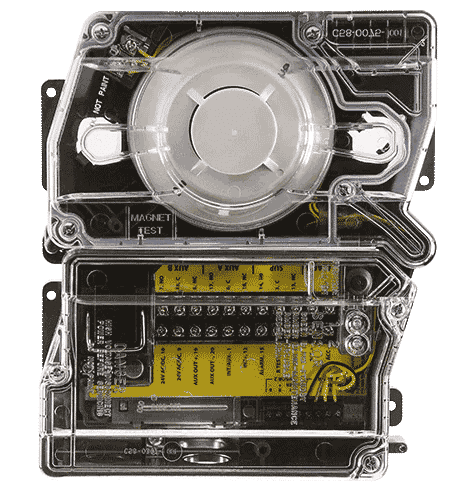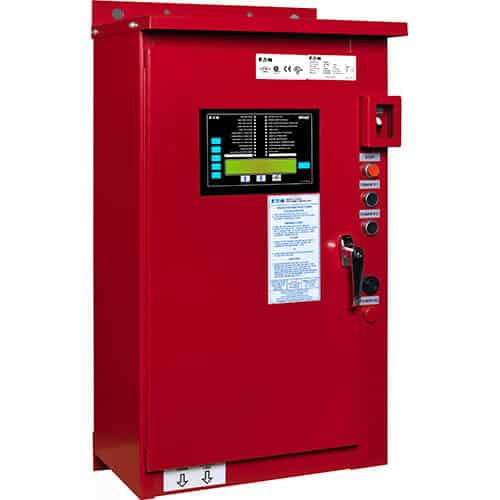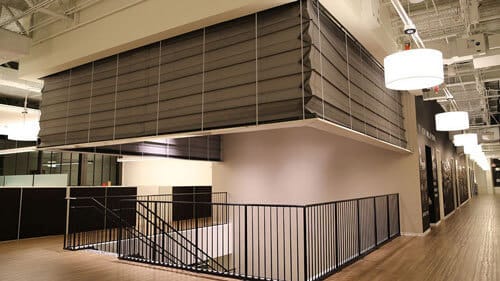How does a fire alarm system work?
You rely on us to be the fire alarm experts.
But have you ever wondered how your building’s fire alarm system works? Every system is different, and different building and occupancy types create different requirements. In this article we’ll walk you through the basic features of most alarm systems.
Purpose
On a high level , the fundamental purpose of a fire alarm system is to perform the following functions.
- Provide indication and warning of abnormal fire conditions.
- Alert the building occupants.
- Summon aid in adequate time to allow for occupants to travel to a safe place.
- Integrate into a life safety plan combining:
Prevention
Protection
Egress
Other safety features particular to the occupancy type
(This language was adapted from the 2016 NFPA 72 A1.2)

Local Indication of an Event
The panel will display the details of any event or condition that it detects. Most signals will fit into one of three categories:
- Alarm – There is a fire condition. The fire department is being called and building occupants should be directed to evacuate.
- Trouble – Something is wrong. This could be due to power loss, a cut wire, or a number of other issues.
- Supervisory– A point on the system is active, but it’s not a fire condition. Points can be set up to monitor other equipment or sprinkler valves that do not necessitate an evacuation or fire trucks, but do require someone on-site to be aware of the issue.

Remote Indication of an Event
Many systems will have a remote annunciator in a main lobby or common area. The system will display the same infonnation that’s shown on the fire alarm control unit; however, some annunciators only show a condensed version of the system information. Types of annunciators include LCD annunciators, which display word-for-word what the panel displays, LED annunciators which usually indicate a more general building zone where the condition is, and interactive graphic annunciators which can provide detailed maps and response instructions to authorized personnel.

Inputs: Initiating Devices
Inputs on a fire alarm system are called “initiating devices” because they initiate the signal back to the panel. initiating devices include:
Manual stations
More often known as “pull stations” since they usually require you to pull down on them to generate an alarm. Most other types of initiating devices require no human involvement, but a manual station exists for a person to be able to initiate the fire event if they need to.

Spot-type smoke detectors
These are most commonly installed on the ceiling and usually have a listed coverage radius of 21 feet, meaning they are designed to detect smoke conditions from a source up to 21 feet away. The two most common types of spot-type smoke detectors are photoelectric, which detects smoke based upon light-scattering technology in the smoke chamber, and ionization, which uses a small amount of radioactive material to detect the smoke particles.

Heat detectors
Heat detectors can detect heat via the fixed temperature principle, where they are set to activate at a certain temperature. The most common fixed-temperature heat detectors activate at 135 degrees Fahrenheit. There are also heat detectors known as “rate-of-rise” detectors, which activate upon a certain temperature increase over a period of time. Many rate-of-rise detectors for instance, activate when there is a 15–degree temperature increase within 60 seconds.

Duct-smoke detectors
Duct detectors are intended to detect smoke that is circulating through the building’s HVAC ductwork. Duct detectors mount to the side of the ductwork and have sampling tubes that protrude Into the ductwork, forcing a certain amount or air to flow through the detector mounted inside of its housing. Because of their susceptibility to false alarms from dust contaminants, duct detectors are programmed as a “supervisory” signal instead of an alann in most jurisdictions.

Beam detectors.
Beam detectors can cover large areas with fewer devices than spot-type detectors. Some beam detectors will cast a beam to a reflector, then measure the beam strength returning. If the beam is partially blocked by something such as smoke, it will create an alarm. If it is FULLY blocked by an person or an object such as a balloon or rack equipment, it will create a trouble signal since smoke alone would not likely fully block the beam path.
Other beam detectors can cover even wider areas through the use of emitters. Multiple emitters can shoot beams back to a central imager, which can measure the beam signal on multiple beams at once. Due to the method of imaging both infrared and ultraviolet beams, this detector will be less susceptible to false alarms than a reflected beam detector.

Air-sampling detectors.
Air-sampling detectors have networks of pipe connected to them with holes or capillaries at each sampling point. The central detector acts like a vacuum cleaner, continuously sucking air from all of the sampling holes and measuring the smoke levels in real-time. These types of units are commonly used in clean-rooms and critical-process areas, because of their ability to detect smoke at very low levels, often well before a full-blown fire can break out.

Water/low switch
Sprinkler systems are central to the life-safety requirements of many buildings. For this reason, multiple sprinkler point types are commonly monitored by the fire alarm system. One such device is the water/low switch.
Each sprinkler head on a sprinkler system is designed to burst when it reaches a certain temperature, usually ben.veen 135 to 170 degrees Fahrenheit. The exact temperature range is identified by the color of the glass bulb using a universally adopted color code system.
If a sprinkler head anywhere on the system bursts to extinguish a flame, water will flow through the central sprinkler riser and past the flow switch, which will send an alarm back to the panel, These flow switches typically have a delay built into them, due to expected fluctuations in city water pressure. However, the delay between the time water starts flowing and the time there is an alarm at the panel cannot exceed 90 seconds.

Valve tamper device
Sprinkler systems generally have multiple shutoff valves, some outside and some inside. Any valve that restricts water to the building’s fire sprinklers is required to be monitored by a tamper switch. These switches are programmed to display a “supervisory” condition at the fire alarm panel since the condition itself is not an alarm, BUT does pose a potential life-safety impairment if there were a fire and the water could not flow to the necessary sprinkler heads.

Air pressure switches.
Sprinkler lines serving outside areas cannot stay filled with water because they may freeze and burst. The most common solution installed is a “dry system” which allows air pressure to be substituted for water pressure. When a sprinkler head bursts, the air pressure will drop and allow the lines to fill with water, flooding the fire areas. Because it is critical for these systems to maintain a specific air pressure, the fire alarm system monitors for “low air” and “high air” conditions. These signals will display a “supervisory” condition at the panel so that authorized personnel can address the loss in air pressure, or the failure of a compressor’s pressure regulator.

Flame detector
Most commonly used in industrial applications where a fire needs to be detected before smoke is even produced, a flame detector detects unique IR signatures caused by flames.

Line-type heat detector
This type of detector is a wire which has conductors that make contact under a certain temperature, The conductors are coated with a special polymer that separates under specific heat conditions, creating lower resistance and creating an alarm condition. Once the polymer separates, the wire or that section of the wire needs to be replaced.

Status monitoring of other systems
Other systems and their processes are commonly monitored by the building fire alarm system, such as fire pump functions, generator running conditions, and other fire alarm systems in the building such as pre-action or releasing systems. Multiple points may be monitored on any given system. Some may be alarm signals, and some may be supervisory signals depending on the specific event.

Outputs: Occupant Notification
Notification Appliances
Occupant notification employs “notification appliances” such as strobes, horns, horn strobes, speakers, and speaker strobes. These usually come in red or white, and in a ceiling or a wall-mount version. Voice-based systems that employ speakers and speaker-strobes are often used in places of assembly, amusement, high rises, or educational facilities.

Outputs: Emergency Control Functions
Emergency control Functions are outputs performed by the fire alarm system, usually with a relay or control module such as this one. Emergency control functions encompass a variety of system interfaces, often designed to slow the spread of smoke or flame between areas, or to safeguard life for as long as possible. Some examples include elevator recall, where an elevator is sent to a designated floor upon a fire in a different elevator lobby.
Smoke curtains
are sometimes employed to control the spread of smoke and prevent fatal smoke inhalation while occupants evacuate.

Fire doors
magnetic holders are a common form of smoke and flame control, releasing all open doors upon a fire event.

Door Unlocking
Building codes often require doors to unlock for egress concerns, such as mag locks or stairwell doors in high rise buildings.

Air handler shutdown
Emergency control !unctions are also employed to shut down air handlers and prevent the circulation of smoke, as well as preventing new outside air from feeding any flames.

Fire Smoke Damper (FSD) Closure
Fire-smoke dampers are also employed to close off sections of ductwork to further prevent the circulation of smoke upon a fire event.

NAC Panel Activation
Control modules are commonly employed to trip remote NAC panels that control strobes or horns in particular sections of a building.

Suppression System Activation
Control modules are also used to activate suppression systems in environments such as server rooms where fire must be not only detected, but extinguished.

Reporting of Conditions Off-Premise
Systems usually connect automatically to a monitoring company, or “central station”, whose job is to interpret and forward the signals to the right people, Systems connect to the central station via a number of methods, such as a cellular communicator, radio communicator, or IP communicator. Older systems used two phone lines as the sole means of communication to the central station, which is no longer allowed for new installations due to increasing unreliability of the publicly-switched telephone network. Many systems installed under older codes still use phone lines however.
Most systems report the full event and the specific device causing the event.
Some systems, especially older systems, report a general alarm, general trouble, or general supervisory with the communicator simply monitoring the alarm, trouble, and supervisory relays at the panel.
Regardless of whether the panel sends point reporting or simply type reporting, the monitoring company will typically respond In this way.
For alarm signals, they will call the fire department or dispatch agency first, then call the customer.
For trouble or supervisory signals, they will call the customer.

Responsibilities of the building owner
The building owner is required to maintain their system by ensuring periodic testing on their system. Periodic testing includes both visual and functional inspection and testing of your system. The NFPA 72 (National Fire Alarm and Signaling Code) dictates different testing frequencies and methods for different types of equipment.
Point Monitor offers professional periodic testing services. We work with you to ensure your building is in compliance, and if it’s not, we help you pave a path towards compliance. Have questions about testing frequencies, methods, or other requirements? We’d love to chat.

